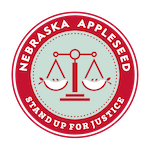This Foster Care Awareness Month, we are reflecting on the thousands of young people and families affected by Nebraska’s child welfare system, especially those vulnerable to unnecessary system involvement.
This week’s focus is Families of Color.
Families of color are disproportionately represented in the foster care system with disparities growing at each stage of a case. This is especially true for Black and Native youth as a result of historical and still existing inequities inflicted upon their communities, making them more vulnerable to being under resourced and over policed.
For example, 53% of Black youth will be the subject of a child welfare investigation by the time they turn 18 as compared to only a fourth of white youth. Native youth are represented in the system at twice their makeup of the general population.
Nebraska is especially bad at this compared to other states:
- Black and Native youth are represented in our system at rates of 2.5 to 4 times their makeup of our general population – which is double the national disproportionality rate.
- A 2022 study compiling disproportionality data across the country named the 10 states with the worst disparities for Black, Native, and Latinx youth by child welfare investigations. Nebraska was the only state to rank in the top ten worst list for each of those categories, and was 3rd and 4th worst for Black and Native youth.
To be very clear – families of color are more likely to be in the child welfare system to no fault of their own. Research demonstrates families of all races and ethnicities experience circumstances triggering potential system involvement (being low income, leaving children briefly unattended, or casually engaging in substances like alcohol) – Families of color are just more likely to be seen as unsafe.
For example, communities of color are historically under-resourced and under-cared for, leading them to be more likely to be low income and in need of supports. Yet, they can’t access those supports safely without being reported to the child welfare system for needing support, or for failing to ask for help in the first place. Additionally, their communities are more policed than white communities, and with the additional burden of biases, assumptions, and stereotypes against them, such increased surveillance leads to more opportunities for judgments that their children are unsafe. And even in interacting with people on a day to day basis – neighbors, doctors, educational providers – such biases cause increased negative judgments against them and higher likelihood of child welfare reports, even when white families around them are in the same situations. Then, once reported, those assumptions continue to count against them, all throughout their case.
As a result, families of color are more likely to have child welfare cases and experience the resulting harms: family invasion, separation, trauma, and involvement in other systems, including the criminal justice and public benefits systems – all perpetuating the continued cycles of disparity for communities of color.
And of course, all of this is especially troubling when we remember that almost all families are in the child welfare system for being low income – not for being intentionally unsafe.
The child welfare system’s treatment of families of color is unjustifiable, and with Nebraska’s especially bad disproportionality rates, it is clear we can do better. All families deserve to thrive together – without fear of unjustified child welfare system invasion.
Continue following our social media this Foster Care Awareness Month for more reflections and future suggestions on policy improvements to reduce these disparities. In the meantime, here are resources you can explore to learn more:
Read | Browse: Black Families Matter: How the Child Welfare System Punishes Poor Families of Color, The Appeal
Watch | Listen: The Importance of the “Indian Child Welfare Act”, Native American Rights Fund
Deep Dive: Read “Torn Apart: How the Child Welfare System Destroys Black Families…” by Professor Dorothy Roberts

